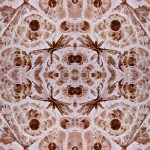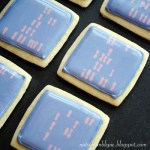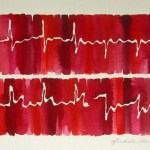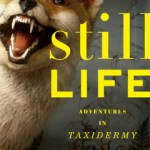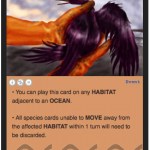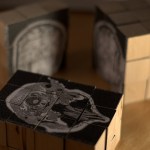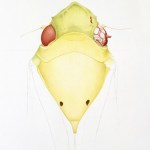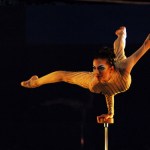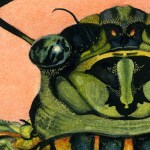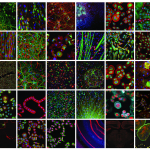biology
"Fossil geometry" (detail)
Based on Eschschottzia Californica seeds collected by Mr W Reeves, April 1864.
From the collection of the Royal Microscopic Society.
UK sci-artist Heather Barnett has created a line of wallpapers using micrographs of cells, crystals, seeds, nanofibers, etc. They'd be particularly striking in a loft or other industrially inspired space - including a lab or a clinic waiting room. Come on, PIs, you can squeeze a wallpaper budget in your next grant application, can't you?
"Fossil geometry" (repeat)
Check out more of Barnett's biological wallpapers below the fold…
Lately Ms. Humble of Not So Humble Pie, "your typical nerdy biological anthropologist turned stay at home mom and baker of sometimes strange goodies," has cornered the market on science cookies. Check out her beautiful gel electrophoresis cookies (above): they are amazingly convincing AND ethidium bromide free (thank goodness). She's also made drosophila melanogaster cookies, zebrafish cookies, circuit board cookies:
wii-mote and Six axis controller cookies (not science, but come on, gamers and scientists have a high overlap), and blood cell cookies. Check out this educational video using…
DC area artist Michele Banks works with wet-in-wet watercolor to create abstract paintings of biological subjects - lots of cells, mitotic spindles, etc. You can see more of her work at her Makers Market shop (under the nom d'art Artologica), or at the SoWeBohemian Festival in Baltimore this weekend.
My friend Shana mentioned this one to me: it's an LED sculpture that opens at night and folds closed during the day, like a light-sensitive flower. The creator, Wendy Legro, says: "The sun is our natural light source. Our homes are filled with artificial light replacing it, undeliberately disrupting our biological clock. This product works autonomously with a light sensor. During the day, mechanical flowers are closed enabling sunlight to come in. When sun sets, the flowers open and start to emit light. In this way, awareness for a beautiful phenomenon will be brought back."
I'm not usually…
Edge.org has invited comments on Craig Venter's synthetic bacterium from thinkers like Freeman Dyson, George Dyson, and our very own PZ Myers. Nassim Taleb is particularly pessimistic:
If I understand this well, to the creationists, this should be an insult to God; but, further, to the evolutionist, this is certainly an insult to evolution. And to the risk manager/probabilist, like myself & my peers, this is an insult to human Prudence, the beginning of the mother-of-all exposure to Black Swans. Let me explain.
Evolution (in complex systems) proceeds by undirected, convex bricolage or…
Here's another interesting summer reading prospect for BioE-philes: Still Life: Adventures in Taxidermy by Melissa Milgrom. From the New York Times review:
The best chapter in "Still Life" by far is the one in which Ms. Milgrom visits with the fascinating and foul-mouthed British artist Emily Mayer, the woman who is Mr. Hirst's taxidermist. She's the woman who, we learn, "repairs the sharks, preserves the grizzlies, assembles the skeletons, and casts the cow heads for his multimillion-dollar artworks." Ms. Mayer is a Tim Burtonesque perfectionist: "I can't have a piece for Damien discolor in…
Apparently the Republicans learned nothing from Change.gov and the White House's problematic experiments with crowdsourcing, because they've now invited web-based public input to shape their 2010 party platform. According to Dana Milbank, so far, the suggestions include such gems as "A 'teacher' told my child in class that dolphins were mammals and not fish! And the same thing about whales! We need TRADITIONAL VALUES in all areas of education. If it swims in the water, it is a FISH. Period! End of Story." Mmmmkay.
Unless the commenter uses a giveaway pseudonym, it's tough to tell if such…
As you may know, the Phylo (Phylomon) project is crowdsourcing a collection of ecology-based trading and gaming cards, in the hopes of supplying kids with a more engaging way of learning and thinking about their environment. And here's a timely addition: the Oil Spill, with very nice artwork by Stephanie Tan. Scientist-artist types: have ideas, or artwork, to contribute to Phylomon? Check out their website for more info!
l cannot fathom why Robert Gibbs, the President's Press Secretary, would dispute that the animal scurrying past the President's feet is a vole. The short tail, the shape, the fur, all scream meadow vole (Microtus pennsylvanicus). And yet:
"Where I'm from, that's a rat" Press Secretary Robert Gibbs declared Friday, a day after whatever-it-is scurried from one set of bushes to another in the Rose Garden right in front of the President Barack Obama's podium as he spoke to reporters.
It's a vole. The AP quotes a Cornell biologist saying the same, but I've trapped enough voles to know, too.…
Der Mensch als Industriepalast [Man as Industrial Palace] from Henning Lederer on Vimeo.
So awesome! Fritz Kahn's poster reimagined as an animation by Henning Lederer. Via Bora.
They're using DNA tests for everything now - even to catch canine vandals and their miscreant owners.
Robert Frost was right: good forensics make good neighbors.
Somebody in charge of pulling flickr illustrations for Wired's website has a good eye - they used this photo by Stephen Hampshire. A quick visit to flickr, and it turns out the photo is of Hampshire's homemade version of a DIY project originally described by Neil Fraser: a wooden cube brain map/puzzle. Fraser summarized his creation thus:
Last month I took a left-right MRI scan, reconstructed it, and rerendered top-bottom and front-back scans. It was interesting to manipulate the data and extract information which while previously present, was not previously visible. Another method to…
The tail of a thresher shark (Alopias vulpinus). From Wikipedia.
Thanks to sensational documentaries and summer blockbusters, we are all familiar with the anatomy of a shark attack. The victim, unaware that they are in peril, is struck from below and behind with such speed and violence that, if they are not actually killed during the first strike, they soon find themselves a few pounds lighter in the middle of a billowing red cloud. The trouble is that this stereotyped scenario does not hold for all sharks, particularly one peculiar group of deepwater sharks which has long puzzled…
Cornelia Hesse-Honegger's beautiful book Heteroptera is one of my most treasured natural illustration collections. Unfortunately, it seems to be out of print now, but Wired recently compiled a gallery of her work, and I highly recommend a visit.
The subtle and not-so-subtle asymmetries on Hesse-Honegger's specimens, like the cyst-eyed cicada above, are latently sinister: these are insects collected near Three Mile Island, Chernobyl, nuclear plants, and sites downwind of nuclear test grounds. Are the defects Hesse-Honegger catalogs a telltale sign of environmental contamination? Or is she…
"Music is perpetual, and only the hearing is intermittent." -Thoreau
A couple of weeks ago, my wife and I went to the circus together. Someday, I vowed, I'll be strong, flexible, and stable enough to do the amazing hand-balancing tricks we saw.
And all the while, the six-year-old girl behind us screamed her piercing, high-pitched scream, cheering the performers on.
(This is totally appropriate behavior, IMO, and no children reading this should be discouraged from screaming at the circus.)
Now, one of us has better hearing than the other. And while one of us found the high pitched screaming…
Recently a reader commented that my painting, Fall:The Cicada, is a little, um, insect-y. Yes, I have a propensity to paint insects-lots of 'em. I have a box of dead ones just waiting for the day I get around to painting them, so I thought I'd explain why. About the same time, I was encouraging a friend who is also an artist to start blogging about her works-in-progress. I don't have any works-in-progress at the moment, but I figured why not follow my own advice, so here you go: a post about painting insects.
I enjoy insects as subjects because they're like tiny jewels, each one with many…
tags: How we Wrecked the Ocean, oceans, fish, fishing industry, introduced species, biological pollution, chemical pollution, climate change, coral bleaching, Jeremy Jackson, TEDTalks, TED Talks, streaming video
In this bracing talk, coral reef ecologist Jeremy Jackson lays out the shocking state of the ocean today: overfished, overheated, polluted, with indicators that things will get much worse. Astonishing photos and stats make the case. So in a nutshell: we've wrecked everything around us: the water, the air, the animals, the climate, and any illusion of world peace we ever had. We're…
Anyone who's been reading this blog for any length of time longer than a few weeks knows what I think of Deepak Chopra. Indeed, he's been a recurring topic here since the very beginning (just type his name into the search box for this blog if you don't believe me). In fact, Chopra has "distinguished" himself by becoming a fairly recurring target on ScienceBlogs in general and a number of skeptical blogs, including SkepChick and NeuroLogica Blog. The reason should be obvious. No one--and I mean no one--lays down the quantum dualistic woo the way that Deepak can. Whether it be abusing genetics…
[U]nlike artists or musicians, we do have competitors. Only van Gogh can paint like van Gogh and the uniqueness of Beethoven's music is immediately recognizable. Their contributions are irreplaceable. But individual scientists are not irreplaceable. There are many, many examples of important discoveries being made simultaneously by several individuals or groups working independently. The social scientists have all manner of explanations for this "phenomenon" but the bottom line is this: If I am not the first to discover, almost certainly someone else will be. No wonder we are so desperate to…
These are images of cells from GE's IN Cell Analyzer Competition 2010:
every year we invite IN Cell Analyzer users to submit their images to the IN Cell Image Competition. This year we have received over 70 fabulous images from researchers' worldwide, working in areas such as toxicology, malaria, dermatology, obesity, cancer and neurology.
See the full-size images in all their fluorescent glory, and the winners from 2009, at GE's flickr page.
